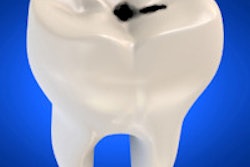
Silver diamine fluoride (SDF) arrests dental caries by reducing the demineralization process and inhibiting the growth of multispecies cariogenic biofilms, according to a new study in Annals of Clinical Microbiology and Antimicrobials (February 26, 2013).
A team of researchers from the University of Hong Kong and Anhui Medical University used a computer-controlled artificial mouth to study the effect of 38% SDF on cariogenic biofilms and dentin carious lesions.
"Clinical studies have shown that SDF is effective in arresting dentin caries and enamel caries, but its mechanism of action remains unclear," they wrote.
For this study, the researchers prepared 72 human dentin blocks using sound third molars. Half of the blocks' surfaces were coated with acid-resistant nail varnish to serve as an internal control. Twelve of the blocks were embedded in an acrylic resin disk designed to fit inside the artificial mouth.
The researchers then applied five common cariogenic bacteria -- Streptococcus mutans, S. sobrinus, Lactobacillus acidophilus, L. rhamnosus, and Actinomyces naeslundii -- to the blocks and incubated them for three days to create a cariogenic biofilm that generated carious lesions on the exposed surfaces of the blocks. The lesions had a depth of about 70 microns.
Half of the blocks were assigned to the test group and half to the control group. In the test group, 38% SDF (containing 253,870 ppm of silver and 44,800 ppm of fluoride ions) was applied to the exposed surfaces of the blocks, while the blocks in the control group were treated with sterile distilled water. All the blocks were then incubated in the artificial mouth, where they were subjected to a continuous humidified gas mixture a simulated oral fluid designed to mimic salivary flow. In addition, a 5% sucrose solution was supplied for six minutes every eight hours.
Inhibitory effects
After seven days, 24 blocks (12 test, 12 control) were removed and evaluated using colony-forming units (CFUs), scanning electron microscopy (SEM), and confocal laser scanning microscopy. In addition, the physical properties of the lesions were evaluated using microhardness testing, energy dispersive spectroscopy, and Fourier transform infrared spectroscopy. Another 24 blocks were evaluated after 14 days and the remaining 24 blocks at 21 days.
The CFU results revealed fewer CFUs in the test group than the control group (p < 0.01), while the SEM and confocal microscopy showed less bacteria growth in the test group and confluent cariogenic biofilm in the control group (p < 0.01).
"This study demonstrated SDF-inhibited cariogenic biofilm formation," the researchers wrote. "The inhibition was obvious in the first 7 days after SDF application based on a very low CFU counting, and the CFU increased over time."
Both the silver and fluoride ions released from the SDF appeared to have inhibited the cariogenic biofilms, they noted. In addition, "precipitates containing high silver and phosphorus content were observed, including the tubule orifices after SDF application," indicating that the presence of SDF helped minimize mineral loss. The researchers also found that SDF has an inhibitory effect on matrix metalloproteinases, which play a critical role in collagen breakdown in carious lesions.
"SDF has been used to manage caries, in particular, in patients with high caries prevalence, [and] its simplicity of application enables its use on young children," the researchers wrote.
According to the study results, 38% SDF arrests dental caries by reducing the demineralization process, minimizing the loss of mineral content, and slowing collagen I destruction, they concluded.



















